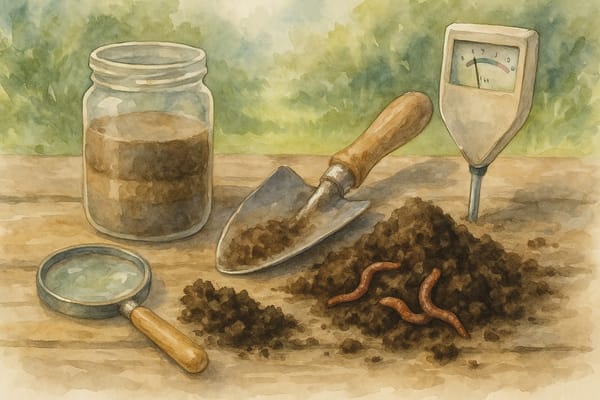How to Measure Soil Health at Home (and Why It Matters)
Explore simple ways to test your garden soil at home and uncover the hidden life beneath your feet—with hands-on methods that reveal structure, microbes, and resilience.


Explore simple ways to test your garden soil at home and uncover the hidden life beneath your feet—with hands-on methods that reveal structure, microbes, and resilience.


Understanding the unseen vitality beneath your feet
Soil may seem like a static backdrop to your gardening, but in truth, it’s a living, breathing ecosystem—and one of the most important elements shaping your success. For gardeners in Cornwall and beyond, learning to measure and understand soil health isn’t just an academic exercise. It’s a way of tuning in to the rhythms of your plot, diagnosing problems before they escalate, and celebrating the often-invisible work of worms, microbes, fungi, and roots.
You don’t need a lab or a soil science degree to do this. With a few simple tests—and a little curiosity—you can begin to read your soil like a seasoned grower.
Why Measure Soil Health?
Beneath every healthy plant is a healthy soil—and behind every struggling bed is usually a soil that’s missing something. Learning to assess soil health gives you a window into:
And it’s not just for big growers. Even in a single raised bed or container, understanding the signs of living soil can change how you garden.
Simple Soil Health Checks You Can Do at Home
These home tests require little more than your hands, a jar, and a few basic tools—but they reveal a lot.
1. Soil Structure and Texture
2. Organic Matter and Life
3. Compaction Clues
4. Signs of Life Under Mulch Lift a mulch layer or composted patch and look for white fungal threads, beetles, pillbugs, springtails or centipedes. The more you see, the healthier and more biologically active your soil is.
A Step Further: Home-Based Biological Insights
If you’re curious to go deeper, there are a few creative ways to get closer to your soil’s microbial activity:
When to Test and What to Watch For
Soil testing isn’t a one-off job—it’s something you can do seasonally to watch for changes:
Signs of truly healthy soil include:
Tools You Can Use (Optional)
In Cornwall’s Gardens: A Local Lens
Cornwall’s long seasons, rain-rich climate, and mild winters are a gift to soil life—but they can also lead to compaction, waterlogging, or nutrient leaching. Simple home tests help you adapt and respond. Look at composted seaweed and leaf litter under a hedge in winter—you’ll likely find fungal threads and happy beetles. That’s the mark of living, resilient Cornish soil.
And for those involved in community plots, school gardens, or permaculture projects—these simple soil tests are powerful tools for shared learning and building a culture of care from the ground up.
Takeaway Actions for Your Season
The more you get to know your soil, the more confident and connected you’ll feel as a grower. Not just tending the surface, but cultivating a vibrant underground world, one handful at a time.